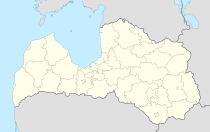Grobiņa
| Grobiņa ( German : Grobin) | ||
|---|---|---|
 |
|
|
| Basic data | ||
| State : |
|
|
| Landscape: | Courland ( Latvian : Kurzeme ) | |
| Administrative district : | Grobiņas novads | |
| Coordinates : | 56 ° 32 ' N , 21 ° 11' E | |
| Residents : | 3,977 (Jan. 1, 2016) | |
| Area : | 5.12 km² | |
| Population density : | 777 inhabitants per km² | |
| Height : | ||
| City law: | since 1695 | |
| Website: | ||
| Post Code: | LV-3430 | |
| ISO code: | ||
| Old Mill | ||
Grobiņa ( German Grobin ) is a small town in Courland , in western Latvia ; 10 km from Liepāja / Libau . In 2016 Grobiņa had 3977 inhabitants.
history
Between the 7th and 9th centuries there was a large settlement of traders of Scandinavian origin here, which is comparable to the Staraya Ladoga complex . Excavations in 1929/30 discovered three grave fields with a total of 3000 graves in cremations, with weapons and jewelry of the Scandinavian type from the Vendel period . The finds from two burial grounds are of Gotland origin, those from the third burial ground are assigned to the Mälar Valley in central Sweden . They date from between AD 600 and 850.
The port for merchant ships was accessible via Lake Libau (Liepājas ezers).
In the middle of the 9th century, Bishop Rimbert first mentioned Seeburg Castle in the Vita Sancti Ansgari on the occasion of the conquest of the Kurfürstendamm by the Swedes under King Olaf. In the following years the importance of Seeburg declined. The Truso trading center took its place.
A brick castle of the Teutonic Order was built in 1269 , the ruins of which can be visited today. During the Livonian War, the order pledged the Grobin Commandery to the Duke of Prussia in order to receive help against the attacks of Ivan IV the Terrible . In 1560 a school was established. In 1659 the area was ravaged by the Swedes and in 1710 an epidemic of plague raged . Grobin flourished in the 17th century thanks to its artisans ( amber turner , hatter, spinner and weaver) and trade. In the 19th century, the rise of Libau caused Grobin to lose its importance.
Dassow in Mecklenburg-Western Pomerania has been Grobiņa's twin town since 2002 .
Grobiņas novads
In 2009 the city merged with four surrounding municipalities to form an administrative unit. (See also: Administrative division of Latvia )
people
- Theodor Schiemann (1847–1921), historian
- Archibald Graf von Keyserling (1882–1951), admiral, born in Augustenhof near Grobiņa
- Kaspars Petrovs (* 1976), serial killer
literature
- Hans Feldmann , Heinz von zur Mühlen (ed.): Baltic historical local dictionary, part 2: Latvia (southern Livonia and Courland). Böhlau, Cologne 1990, ISBN 3-412-06889-6 , pp. 200-201.
- Birger Nerman : Grobin-Seeburg. Excavations and finds. Stockholm 1958
- Astrīda Iltnere (ed.): Latvijas Pagasti, Enciklopēdija. Preses Nams, Riga 2002, ISBN 9984-00-436-8 .
- Sigurds Rusmanis, Ivars Vīks: Kurzeme . Izdevniecība Latvijas Enciklopēdija, Riga 1993, ISBN 5-89960-030-6 , pp. 34-35.
Web links
Remarks
- ↑ Grobiņa ( Memento from January 21, 2009 in the Internet Archive )
- ↑ «Latvijas iedzīvotāju skaits pašvaldībās pagastu dalījumā"
- ^ Birger Nerman, Grobin-Seeburg, excavations and finds. Stockholm 1958
- ↑ Sigurds Rusmanis, Ivars Vīks: Kurzeme . Izdevniecība Latvijas Enciklopēdija, Riga 1993, p. 34.
- ↑ a b c Hans Feldmann, Heinz von zur Mühlen (ed.): Baltic historical local dictionary. Part 2: Latvia (South Livland and Courland). Böhlau, Cologne 1990, p. 200.

